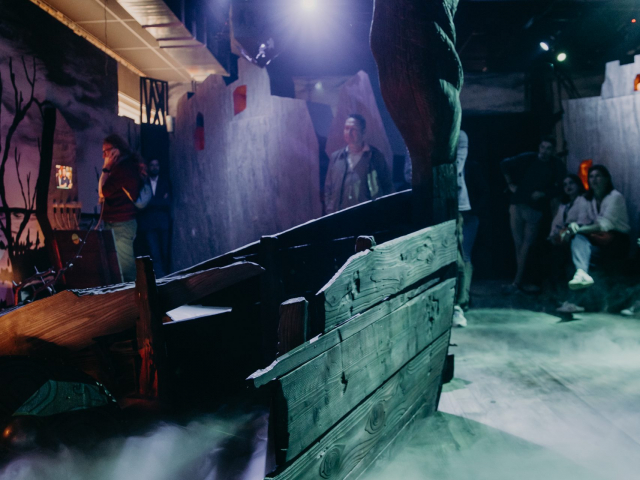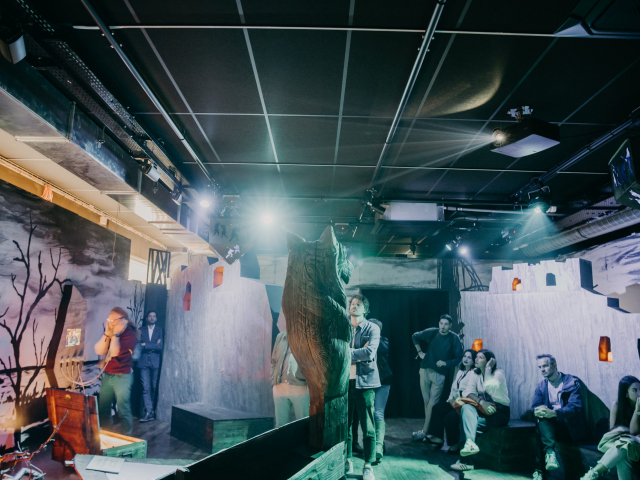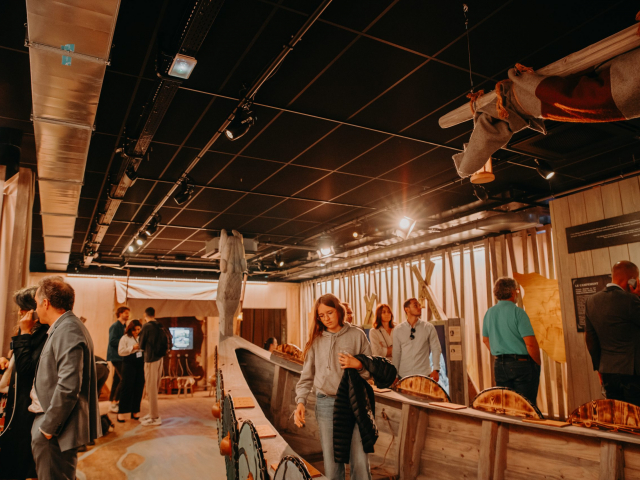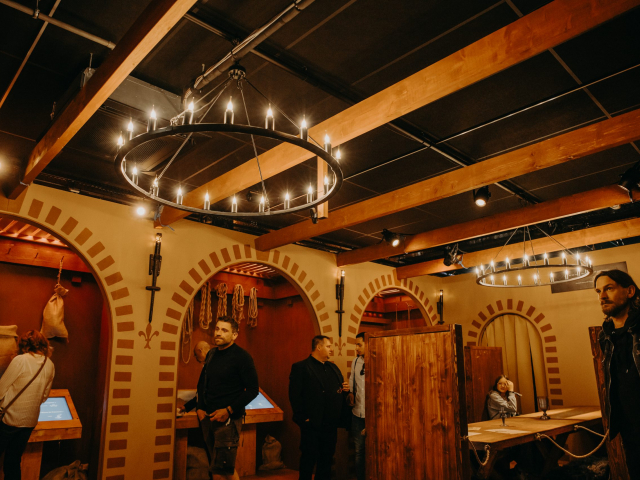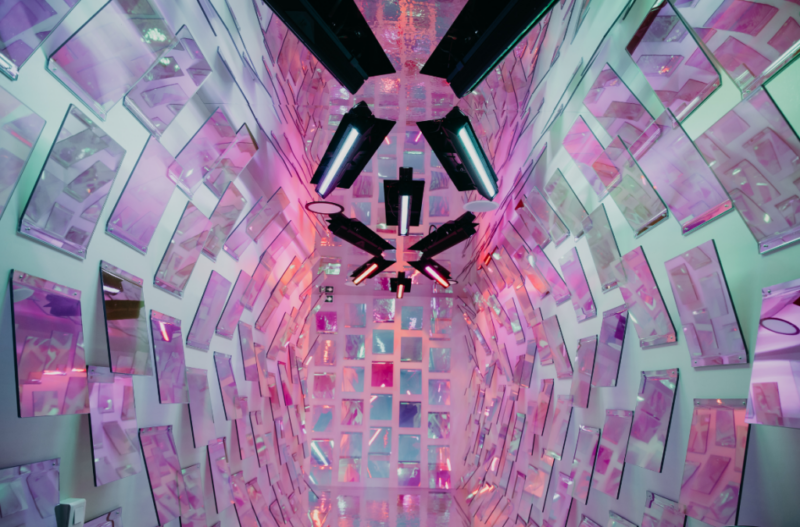
Since 2024, visitors to the Cité Immersive Viking in Rouen, France, have been able to delve into the fascinating world of the Vikings. The multimedia exhibition retraces the Viking invasion of Normandy in the ninth and tenth centuries and brings the culture and history of the region to life in a multimedia and immersive way. The organizers behind the exhibition have commissioned a specialist for the technical planning and implementation: the event technology service provider Novelty. Mathieu Cabanes was responsible for the lighting design of the various exhibition rooms. The renowned French lighting designer originally comes from the world of opera but has also made a name for himself with major corporate and sporting events. In the Cité Immersive exhibition, Cabanes relies on the versatile LED bars from the Cameo PIXBAR® G2 series and the RGBW PAR spots from the Q-SPOT® series, among others.
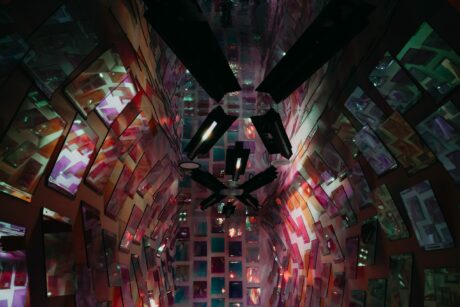 With the Cité Immersive Viking exhibition, the organizers are pursuing a special kind of historical exploration: “My aim was to convey emotions to visitors through the world of the Vikings,” explains Cabanes. “Inspired by real stories and facts, we have created an evolving cycle in each room that tells about different moments in the life of a Viking.” With its numerous video walls, 360° video mapping, 3D sound design, historical reconstructions, and the use of evocative scents, the exhibition combines classic and modern techniques to bring the ways of the Viking to life.”
With the Cité Immersive Viking exhibition, the organizers are pursuing a special kind of historical exploration: “My aim was to convey emotions to visitors through the world of the Vikings,” explains Cabanes. “Inspired by real stories and facts, we have created an evolving cycle in each room that tells about different moments in the life of a Viking.” With its numerous video walls, 360° video mapping, 3D sound design, historical reconstructions, and the use of evocative scents, the exhibition combines classic and modern techniques to bring the ways of the Viking to life.”
“It was important to the client to create an exceptional visual experience for visitors,” adds Morgan Coeurdray from Novelty. “For this, we needed an aesthetic, reliable, precise, and high-quality lighting solution that also stayed within the budget.”
In the Cité Immersive Viking exhibition, every room is different and has its own dramatic composition and characteristics. No room makes this clear quite like “Bifröst” – a space-time corridor that takes visitors from the Viking age to the present day. Cabanes and set designer Sophie Liger worked with dichroic glass for this room. To further enhance the sparkling, iridescent effect of the glass, Cabanes placed the PIXBAR® SMD IP G2 IP65 SMD LED bars in a specific pattern on the ceiling for a dynamic and multicolored visual effect.
In contrast to his work in theatre and opera, Cabanes was able to decide independently which lights he wanted to use for the exhibition. In addition to the PIXBAR® SMD IP G2, the PIXBAR® 400 IP G2 and various Q-SPOT® LED PAR spots in different wattages and LED configurations were also used to show off Liger’s set elements to their best advantage. Cabanes was particularly impressed by the Fresnel spots in the F series which were used to precisely illuminate the longboat (drakkar) in the exhibition: “In addition to the different sizes (F1 to F4), I like the variety of LED modules and housing versions (T, D, FC, PO, IP, FC+). This means I can always find the right light for the application in question. At the same time, the devices can be operated quickly and intuitively. The zoom controls, shutters, and physical potentiometers on the devices remind me a lot of products that we regularly use on TV sets.”
In addition, the lights had to be as compact as possible in order to be integrated as discreetly as possible into the exhibition rooms with their low ceilings. “The technology used forms the basis of the immersive experience but must not distort the creative and historical aspects of the exhibition,” explains Coeurdray. “Ideally, the technology isn’t even perceived as such by visitors.” “Of course, the budget also played an important role,” adds Cabanes. “For me, the price-to-performance ratio of Cameo is almost perfect.”
Further information from Cameo: www.cameolight.com
Here’s an interview with Mathieu Cabanes and Morgan Coeurdray (Novelty) talk about the lighting concept and the special lighting requirements of a museum exhibition.
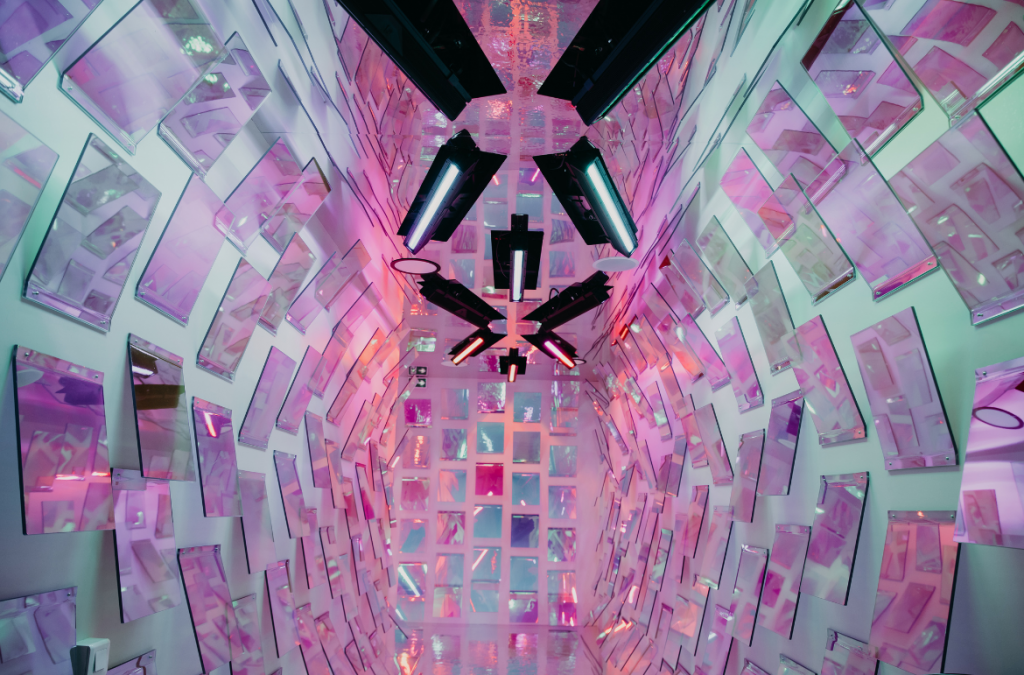
Mathieu, as a lighting designer for theatre and opera productions, how did you get involved in this project?
Mathieu Cabanes: Elizabeth Yardeni, the current production manager of Cité Immersives, used to work at the Paris Opera and found out about me during a performance of Bob Wilson’s Turandot. A mutual friend finally put me in touch with her, and she convinced me to take on this special project.
What is special about it? What attracted you to Cité Immersive Viking?
Cabanes: The Cité Immersive exhibition tackles a historical topic in a unique way. I’m also a huge history buff, and it saddens me that many young people are no longer interested in museums. My aim was to convey emotions to visitors through the world of the Vikings. Inspired by real stories and facts, we created an evolving cycle in each room that tells different moments in the life of a Viking.
Video walls, 360° video mapping, 3D sound design, historical reconstructions, and evocative aromas reminiscent of the passage of the Vikings – the “Cité Immersive Viking” exhibition uses a variety of classic and modern techniques to make the Viking life experienceable.
Morgan, what was Novelty’s role in the Cité Immersive project? What were the requirements that the exhibition organisers came up with?
Morgan Coeurdray: The client wanted to create an extraordinary visual experience for the visitors. To achieve this, we needed an aesthetically pleasing, reliable, precise and high-quality lighting setup that also stayed within budget. We regularly realise installations for museums and cultural institutions and are therefore familiar with this type of project. As we were involved in this project with our teams on several levels, we the client also benefited from a dedicated contact person who monitored the project from the initial discussions through to completion and facilitated seamless communication between the client and the individual departments.
How did you approach the planning of the lighting setup?
Coeurdray: The technology is at the heart of the immersive experience but must not distort the creative and historical aspects of the exhibition. Ideally, the fixtures are not even perceived as such by the visitors. We had to think carefully about where and how to install the equipment in order to minimise the impact on the exhibits and the rooms themselves. Compared to a concert or other temporary event, the requirements here are completely different, which is why we put together our own integration team.
Mathieu, you’re actually from the world of theatre and opera. How does the development of a lighting design for a museum differ from the classic stage?
Cabanes: The decisive difference for me is how the space is perceived. In stage performances, a connection to the audience is usually established from the front, whereby the audience sits in their chairs and looks at a stage that is designed to direct the viewer’s gaze towards specific things. In a museum, we can’t control the visitor’s gaze so easily, and this presents a completely different challenge. Here we need to communicate the magic of a room, but also simultaneously conceal the technology used for this or integrate it into the overall picture in a creative way. In addition, there is no fourth wall (the virtual barrier separating the stage from the audience) as there is in the theatre. The goal is to immerse visitors in the installation and give them the impression of being an active part of the production.
For an exhibition, I need to look at and think about lighting design in a different way. Restrictions exist here that do not play a role in a stage production, such as the luminosity, the UV amount, and the lighting time, which all have an impact on old exhibition pieces. All these factors must be taken into account and vary depending on the type of object to be illuminated. We also started from scratch when it came to the technology – unlike in an opera production, for example, where we generally use the existing equipment and only occasionally lease additional equipment. For this project, it was entirely up to me to decide how many and which types of lights I wanted to use.
Mathieu Cabanes chose the compact Q-SPOT series LED spotlights (15 or 40 watts) for several rooms, in RGBW or TW (Tunable White) versions depending on the intended use. In the Vikings’ “camp”, the lighting designer used the PIXBAR 400 IP G2 LED bars to create indirect light from above, evoking the impression of a natural light shaft. For precise illumination of larger objects, such as the longship (Dakkar) of the Vikings, Mathieu Cabanes relied on the Fresnel spots of the Cameo F series with their adjustable barndoors.
What criteria did you use to select the lights?
Cabanes: Various factors were relevant for me, but the most important was ultimately the value for the money. At the start of the project, the allocated budget was based on simple museography. However, I wanted to create colors, modulations, and atmospheres, and this required not only lights but also a sophisticated control network. The value Cameo offers for your money is perfect. Moreover, I wanted to integrate the lights as discreetly as possible – also because the exhibition rooms have low ceilings – which is why I needed very compact devices. We also had to make sure that the respective LED lights would perfectly accentuate the set elements by set designer Sophie Liger.
How is the lighting operated on site? Does the museum have its own staff for this?
Coeurdray: The exhibition is fully automated and offers an immersive experience without the need for lighting staff to be on site. The show is encoded in a console and played according to a timecode that sets the pace and links to the video. We will be in charge of the maintenance and upkeep of the equipment we have supplied and installed.
Mathieu, do you have a favorite room in the exhibition?
Cabanes: Every room is different and has its own dramatic composition and characteristics. If I had to choose, however, I’d pick the room with the smoking ruins. This exhibition section deals with the violent invasion of the Vikings, which is why I have created a particularly dramatic light. Among other things, we employ ghostly silhouettes of Vikings who haunted people in their sleep at that time. The overall atmosphere creates the feeling of a violent battle, but at the same time also a contrasting, intimate feeling of contemplation.
Another special room is the “Bifröst” – a space-time corridor that takes us from the Viking age to the present day. Sophie Liger and I worked with dichroic glass for this room. To further enhance the sparkling, shimmering effect, I placed the PIXBAR LED bars in a specific pattern on the ceiling. The way these lighting elements are combined creates a dynamic, multicoloured visual effect that brings us, as visitors to the exhibition, back to reality.
Is there a Cameo model that you were particularly impressed by in this project?
Cabanes: My favorite is definitely the F-Series, which I find very interesting for several reasons. In addition to the different sizes – F1 to F4 – I like the variety of LED modules and housing versions (T, D, FC, PO, IP, FC+), which makes it possible for me to always find the right light for the respective application. It offers outstanding performance relative to its price. In addition, the lights can be operated extremely quickly and intuitively. The zoom controls, shutters, and physical potentiometers on the devices remind me a lot of products that we regularly use on TV sets.
Mathieu and Morgan, thank you very much for your time.
Photos by ©Madame Coco Production
